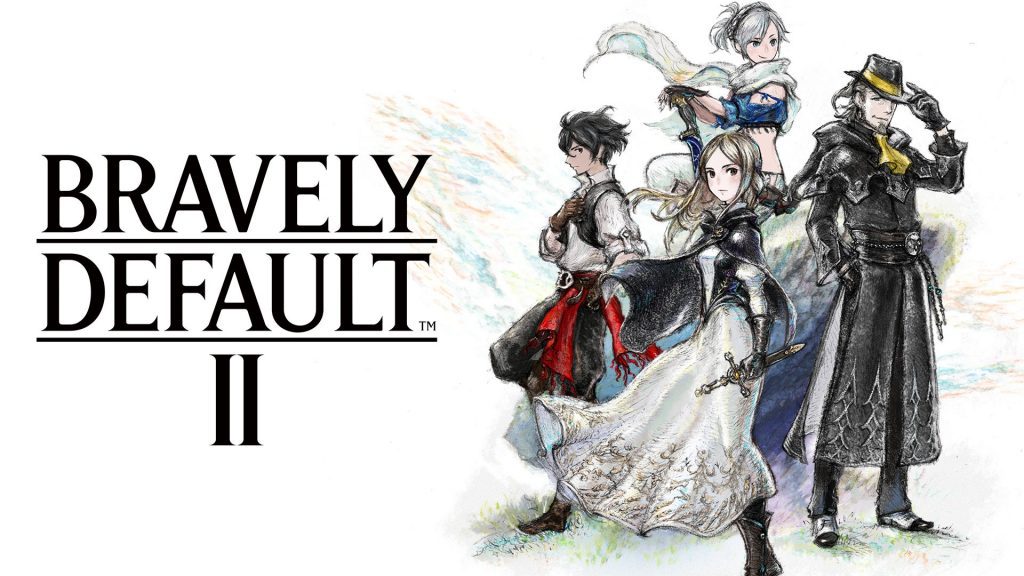I really liked the first Bravely Default (with the job system and interesting battle system), up to a point. That point was the “twist” of how the story works in the second half (or so) of the game. At that point I ended up losing track of what I was supposed to do and eventually gave up. I didn’t play the direct sequel Bravely Second. This one is kinda like a new Final Fantasy, where it’s not really related, story-wise, to the previous games, so I was excited to check it out.
Let’s go and talk about it!
Developer: Claytech Works
Publisher: Square Enix, Nintendo
Release date: February 26th 2021
Platforms: Switch
Genre: Console-style RPG
In a way this game doesn’t change too much from the original Bravely Default. The combat is similar, the graphics are similar (though way better on a technical level here), the job system is similar… But it’s not identical.
The story is nothing super noteworthy. You play as this random sailor who comes out of nowhere (and he has no backstory or anything, it’s pretty weird). He’s selected by the Wind Crystal to be a hero of light after a few early event. You join up with Gloria, the princess from a kingdom that was recently destroyed and 2 travelers, Adele and Elvis (who you learn more about later), in a quest to find all the elemental crystals (very original) and save the world from the big evil who will destroy it. You go to a few different areas, each area having some crystal-based problem (like the desert town being flooded due to the water crystal), usually caused by people who use Asterisks (basically these stones that give you access to job powers) to mess with people in the area for the benefit of the Holograd empire. Once you deal with the problems of the area (and collect all the Asterisks there), you get to the next area. It’s not very revolutionary for a JRPG plot, you’ve seen this same story a hundred times at least. The game does have a twist of course. You can get all the crystals and save the world, but that ending might not be the best. So you reload your endgame save and you get different tasks you can do to get to a different ending. More than once. And maybe some of those are kinda weirdly meta. I’m fine with this twist, generally it’s somewhat straightforward though some of the things you have to do might not be that simple to figure out (there’s one thing I thought was a glitch, but it was an actual hint to what you needed to do). It’s a decent story, you get a bit of character development for everyone except main dude, and maybe one big plot twist later which ends up having very little effect IMO.
Combat is similar to what you’ve seen in Bravely Default and also Octopath Traveler. It uses an ATB-style system, so you have a meter that goes up on each character (and invisibly on enemies), and when it’s full it’s that character’s turn (though unlike an actual ATB system, it does pause when it’s a character’s turn). On a turn, you get to choose from a set of commands. Everyone can attack and defend and use items, while 2 of the options are for skills based on the Main and Sub job that character has equipped. You can also try to run using the should buttons. This is all pretty standard for an RPG of this style. What separates Bravely Default and Octopath from other console-style RPGs is the Brave (or Boost in Octopath) system. If you defend, or Default as this game calls it, you get BP, or Brave Points. There’s other ways to get BP (such as the Revenge passive skill), but Defaulting is the main one. BP can, on later turns, be expended to essentially do more turns at once. You can generally get up to 3 BP, and you can go as low as -3 BP. So even if you’re at 0 BP, you can actually still expend BP. However, if it gets to the turn of a character that has less than 0 BP, their turn is skipped and they recover 1 BP. So it’s all about weighing the pros and cons of doing this. Sure if you spend 3 BP you get to attack 4 times in a turn (or heal/revive several characters) that will deal a good amount of damage, but if you don’t kill everything, that character is now defenseless for basically 4 turns. Maybe your plan is to use 3 BP on each character to try to quickly eliminate the enemy, but if for some reason that fails, that’s your entire party defenseless for 3 turns. I love this kind of risk vs reward mechanics. You can build up BP too with default, but that takes turns to do, but at least you reduce damage on yourself unlike using them up from 0. It’s a pretty well-balanced system. Overall combat is really interesting, but it’s only half of the equation when it comes to battle strategy.
The other half is the job system. Similar to some FF games like FF5, your characters can semi-freely change to different character classes. You gain Asterisks as you progress through the story, and a few in side-quests. Those allow you to change the jobs of your characters. The standard freelancer job has some interesting applications and gets really good if you master all the other jobs. It’s largely as you’d expect otherwise. Thief, several types of mages, phantom, berserker, shieldmaster and so on. When you select a job, you also select a sub job. This enables you to use the active skills of that job. Your main job affects a few things otherwise, namely your equipment mastery (some classes are good with swords while others are good with bows… so if they’re ranked D on something that reduces that equipment type’s effectiveness, while S-rank doubles it) and your main stats. Jobs are leveled up by gaining JP from battles (and JP items), though only your main job gains JP which I’d say is a bit unfortunate. Getting, like, a third of the JP for the sub-job would be really nice. Another thing jobs have is specialties. This is something that was upgraded since the previous game, where each job had one specialty and that’s it. Here each job has 2 specialties, but the second one is only available when you master the job. And that’s one kinda wacky element because when you master a job, generally you’ll probably want to start leveling up another one. So generally you’ll only really use those second specialties in boss battles where you will need to get your best party in there to fight really tough enemies. As a quick note, you only get the access to the specialties of your main job, not your sub job… with some exceptions.
Another aspect of the job system is the abilities. When a job levels up you either get a combat ability (that you can select when it’s your turn) or a passive ability. Those passive abilities can be equipped by a character regardless of what jobs they have selected. So if you’re a Vanguard with a Thief sub-job, you can still equip, say, Berserker passive skills. There’s 5 slots for passives and most passives take just one (a few take 2), so even if you have 2 mage characters with the same classes, they can still end up playing a bit differently based on those passive abilities. There’s a lot of variety here. Some may give different ways to earn BP, maybe boost weapon ranks, allow you to use 2 weapons without stat penalties, maybe use only one weapon but boost the power, maybe drain HP when you attack… there’s a lot of variety here. An interesting set of passives are the sub-job specialty ones (which are on 2 different jobs) which allow you to use the specialties of your sub-job (one lets you use the first specialty, the other lets you use the second specialty on a mastered sub-job).
A lot of experimentation is possible here and you can figure out which combinations are strong. As a hint: Thief as a sub-job is legitimately broken. Beastmaster’s second specialty actually increases your stats for every captured monster and thus make you super strong if you’re taking the time to capture a lot of monsters (at the end of the game my Beastmaster/Thief had more magic attack than my mages despite not using any magic). Even if you only have 4 characters in your party, your massive level of customization makes each of them still feel unique in battle since you’re likely to give them all unique roles in battle (I had a melee unit that focused on defense, a healer/buffer, an attacking mage and a melee unit that caused all the damage because Godspeed Strike is OP).
There’s dungeons but they’re pretty simple, not that worth talking about. They’re mostly mazes. A few of them have minor gimmicks like invisible passages to walk through or walls you can destroy, and side-paths to go through for chests that may contain equipment. Both on the world map and the dungeons, enemies appear directly on the maps and you can try to either avoid them, or sneak up on them and hit them with your sword (which lets you start a battle with an extra BP on each character). Getting hit from behind gives you (or the enemy if they get you from behind) some extra initiative in battle as well.
There’s a ton of sidequests. They tend to give some sort of reward, usually equipment or money, sometimes EXP and JP orbs. Some of them are fine, like asking to defeat some miniboss or something. Some are shit, like asking you to bring something to someone, who asks you to bring something to someone, who asks you to bring something to someone, etc… what even is the point of these kinds of stupid quests? On a separate note, the first Bravely Default had a system that gave you SP if you kept the game powered on while the 3DS was in sleep mode. I honestly don’t remember what SP did. This game has a similar system when you have the game in sleep mode. You have this boat you can send out on expeditions, but it only moves while you’re in sleep mode. When you come back from sleep mode and return to the old woman (who has a house in every main town in the game) later, you get items from said expedition. Generally you get stat-boosting bread, Experience orbs and JP orbs. This is a nice little way to boost your power up a bit.
Difficulty is a bit talking point with this game, but it’s a bit misguided. People who say it’s really hard are people who didn’t actually play it, but rather just played the demo. In the demo, enemies were stupid strong for some reason. In the final game, battles aren’t trivial but they’re not terribly difficult either. Bosses are always a good challenge, but a good party setup will help. In the latter game, bosses get stupid strong though, some of the boss battles are extremely difficult. I did need to do a bit of grinding for some of them, but not TOO much. I did find in many cases that just changing your jobs around a bit worked out pretty well. I guess one complaint with the combat would be how many enemies are able to counter your attacks, it gets pretty annoying.
There’s not really much else to talk about. The equipment system is how you always see it in other games except there’s weight limits (if you’re overburdened you lose stats), getting levels from experience is like in every other game like this… It works. It’s good.
Overall
Overall I had a really good time with this game. This game’s “twist” isn’t nearly as annoying as the first game’s, though some of the things you need to do to advance in the endgame are a bit obscure. One of those things is tremendously meta and I barely even noticed it.
The job system is pretty solid and enables for pretty good customization, some of the classes are super fucking broken (with the thief being one of the big ones surprisingly) but that’s fun to figure out the best combinations. Combat is really fun. The visuals are good though the framerate is abysmal in some places, the music has some bits that are pretty nice, and the story is pretty much standard.
Overall, yeah I’d recommend buying this. It’s a good time. This is closer to what Final Fantasy should be. One day I need to do a big rant about why FF sucks while DQ continues being good. BD2 does something close to what mainline FF should strive towards.








Leave a reply